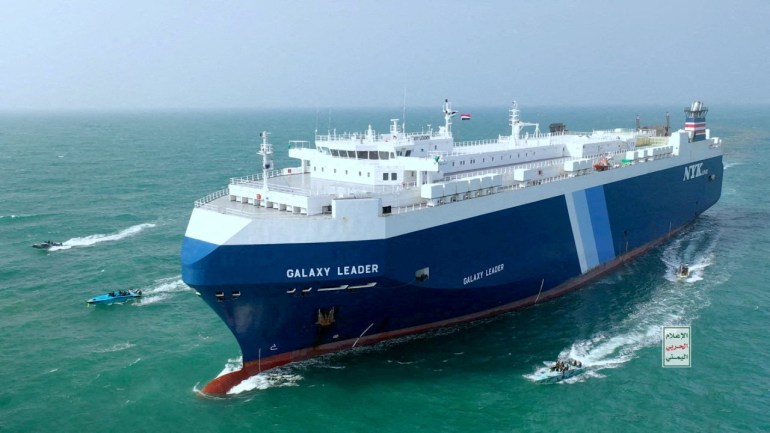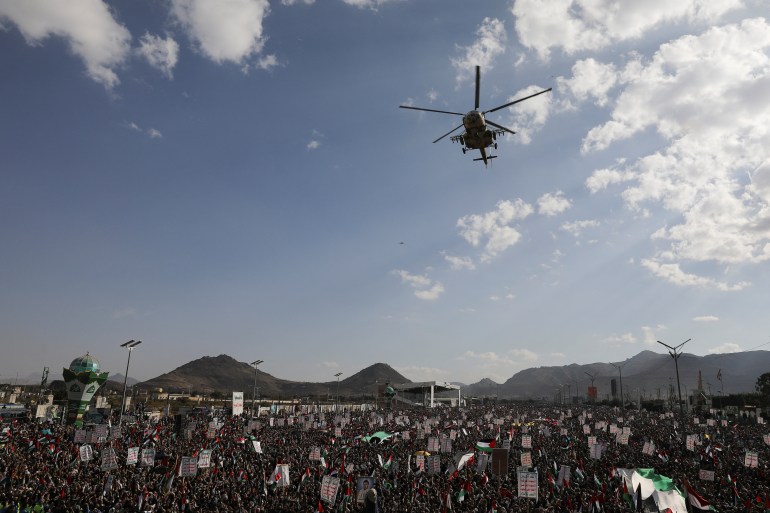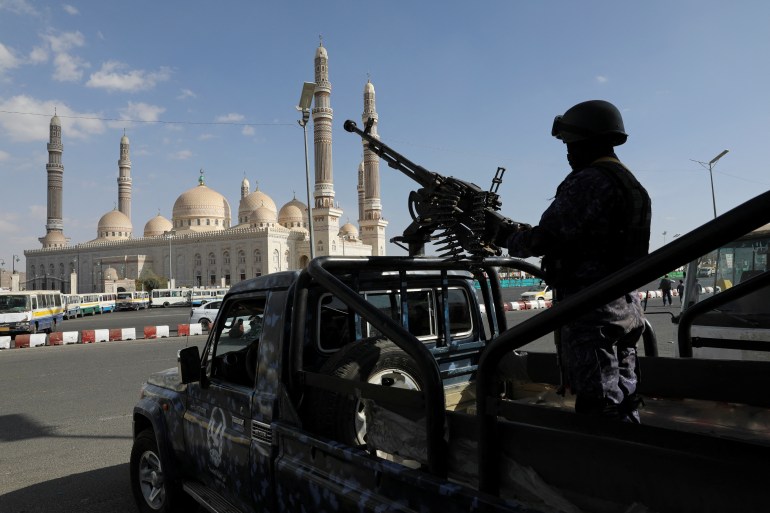
[ad_1]
Beirut, Lebanon — The recent Houthi attacks on commercial shipping vessels in the Red Sea have helped the group drive domestic recruitment and mobilise large rallies in the capital, Sanaa. Analysts say the attacks have provided the group a boost after its popularity had taken a hit in recent months.
But they also warn that domestic moves by the emboldened group could threaten the fragile peace within Yemen, as talks towards a ceasefire to a decade-long-war appear to be gathering momentum.
The Houthis say their attacks in the Red Sea target Israeli-connected or allied ships and are aimed at pressuring Israel to stop its devastating war on Gaza, which has killed more than 22,000 people since October 7.
That’s a message that appears to have resonated with many Yemenis.
Ansar Allah, more popularly known as the Houthis, held a rally in Sanaa in support of Gaza on Friday, drawing millions of Yemenis, according to a Houthi-affiliated media outlet. Images from the event showed a packed al-Sabeen Square, where protesters carried Palestinian and Yemeni flags. The mobilisation took place as the Houthis continued sending missiles and drones into the Red Sea, defying threats of increased military action by the United States.
Amid the heightened tensions in the key maritime waterway, international shipping companies have decided to avoid the Red Sea and go around the southern coast of Africa, adding about nine days to their journey and increasing costs by at least 15 percent. Danish shipping giant Maersk announced on Friday that it would avoid the Red Sea for the foreseeable future.

Undeterred by US coalition
In December the US put together Operation Prosperity Guardian, a 10-country coalition that originally included the United Kingdom, France, Italy, Canada, the Netherlands, Norway, Spain, Seychelles and Bahrain.
Their ostensible aim? To stop the Houthis from targeting commercial ships passing through the Bab al-Mandeb strait, a narrow passageway leading into the Red Sea and further on to the Suez Canal. On November 19, the Houthis took over the Galaxy Leader and turned it into a tourist attraction for Yemenis.
But the Houthis have not been deterred. They have continued targeting commercial traffic in the Red Sea. On December 31, four Houthi vessels tried commandeering a ship travelling through the Red Sea when US Navy helicopters attacked them, killing 10 Houthi fighters and sinking three boats.
On Wednesday, the US and their allies announced what they said was a final warning to the Houthis to stop attacking ships. But at Friday’s rally, the Houthis seemed defiant, as a fighter plane flew overhead, leaders praised the group’s martyrs and declared they were prepared for a military escalation from the US.
“The Houthis seem immune to Western and US pressure,” Sanam Vakil, deputy head of the Middle East North Africa programme at Chatham House, told Al Jazeera.

Ceasefire close
The Palestinian cause is extremely popular among Yemenis. But prior to their attacks on ships in the Red Sea, some analysts said the Houthis had struggled to pay salaries and attract new recruits.
That changed after the Houthis started attacking vessels. Recruitment has spiked in recent months as young Yemenis eagerly enlist in the hopes of fighting for the Palestinian cause. The group recently graduated more than 20,000 new fighters, according to Yemen researcher Nicholas Brumfield. He added that the class was named after Hamas’s October 7 mission, Al-Aqsa Flood.
“The attacks towards Israel and maritime targets in the Red Sea are favouring Houthis’ internal support and recruitment, thus diverting the attention from the social and economic failures,” under their rule in Yemen domestically, said Eleonora Ardemagni, a senior associate research fellow at the Italian Institute for International Political Studies (ISPI). “Direct confrontation with the US is likely to have the same effect.”
A decade-long war with a Saudi-backed coalition, which supports the internationally recognised government of Yemen, dampened enthusiasm surrounding the group. A truce took effect in October 2022 and the parties have since been in ceasefire talks. The two sides seem to have made serious progress with an end to hostilities in sight, the United Nations announced in late December. But analysts believe that the Houthis’ recent actions mean a final deal could still be derailed.
“Their actions continue to foreshadow escalation that could easily trigger a more aggressive US military response that in turn can unravel the fragile ceasefire conditions,” Vakil said.
Brumfield added that “it wouldn’t be the first time that there was progress and the whole thing fell apart at the last minute”.

A teetering truce
The ceasefire could be threatened if the Houthis decide to launch a new domestic offensive, a prospect that some analysts say is a distinct possibility.
In February 2021, the Houthis launched an offensive to seize Marib, the internationally recognised Yemeni government’s last stronghold. The city saw active fighting until the truce was announced in October 2022. But in recent weeks, the Houthis have capitalised on their recent recruitment bump by deploying 50,000 troops around Marib, sparking fears that hostilities could be renewed.
“We’ve seen this very large build-up of forces there over the course of the last couple of months,” Brumfield said. “Within the last week, they’ve deployed even more forces to that location.”
He warned that the relative period of calm in Yemen could soon be over. The Houthis appear to be in position for possible confrontations on both the domestic and regional fronts – on land and at sea.
“For the last 18 months, Yemen has been relatively quiet and that’s been a good thing,” Brumfield said. “It’s just a matter of smoothing out how this war can end and it could very easily go the other way.”
[ad_2]
Source link
